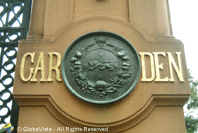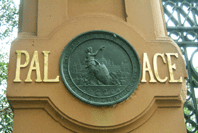It is hard to believe when walking through the wrought iron gates to the Royal Botanical Gardens that one of the grandest buildings in Australia, once stood on these grounds. Built on the hill which was originally used as a run for the governor’s livestock, the Garden Palace stood proudly along Macquarie Street, above the city. The structure stood as a symbol of Sydney and the Colonies emerging growth and maturity as a nation.


Sydney International Exhibition
The Palace was designed by one of Sydney’s most prominent architects, James Barnet (of Sydney GPO Fame) for the Sydney International Exhibitions of 1879-1880. This was an important event for Sydney because it placed the city and also the nation on show to the world. Therefore it was only fitting that Barnet would be given the task of designing something spectacular. Barnet has long been credited to having single-handedly created Sydney’s High-Victorian character.
Barnet with little time to waste had less than 10 months to erect what was originally planned as a temporary building. Over 3,000 labourers were employed on the construction site. Special carbon-arc electric lighting was imported from England to light up the site at night, allowing work to continue around the clock. The only hitch in the rush job was a strike, which occurred following the death of a worker. Most of the carpenters walked off the site demanding higher wages (danger money) but returned a few days later when they realised the Government wasn’t going to give in to their demands (good old days!).
The Garden Palace, which stretched from today’s State Library to the Conservatorium, was completed a week before the grand opening, much to the relief of Barnet, the Government and the 3,000 very tired workers.
Fit For A King
The building which was cruciform (similar to a cathedral) in design consisted of three turret wings that met beneath a central dome. The dome which was the pride of the building was the largest dome in the southern hemisphere and the 6th largest in the world (a tad smaller than the dome of St Peter’s in Rome) having a diameter of 30m. The galvanized iron dome was made up of 36 sided polygon sheaths, with its framework being made from wood. The dome was also one of the main sources of light in the pavilion below, with twenty-six windows built around the base of the dome to let in natural light. The palace also featured four stone entrance towers. In the northern tower, Australia’s first passenger lift (elevator) was installed and was fitted with carpet and seating. The exhibition space on the ground floor covered over 2 hectares.
A Good Time Had By All
The exhibition ran for a little over six months with over 1.1 million people walking through the gates. A grand feat considering the population of New South Wales was 741,142 and Australia about 2.2 million. The countries which exhibited at the event included the United States, Great Britain, Germany, Netherlands, Belgium, France, Japan, Switzerland, India, Ceylon and even New Zealand. One of the most noted exhibits was the demonstration of a washing machine. The building though designed to be temporary structure would later become a concert hall, ballroom, government offices, museum and art gallery.
One Fateful Day in September
In the early hours of 22nd September 1883, the Palace’s night watchman noticed smoke rising from an area beneath the central dome. He went to investigate by opening a door (presumably creating a backdraft) because before you know it a flame burst from the basement and engulfed the building. Within minutes the grand Garden Palace was a smoldering ruin.
The Palace framework, which was mainly timber, contributed to the speed in which the fire spread. As news of the fire spread, crowds gathered by the gates, looking on in disbelief at where the palace once stood. The newspaper, The Sydney Morning Herald, described the event; “the scene was the most imposing, as it was the most pitiful, ever seen in the colonies”. Arson was highly suspected as the cause of the disaster but it could never be proven.
The Garden Palace gates and the sandstone pillars at the Macquarie Street entrance were all that survived of the palace. The gates were designed by Barnet in 1888.
